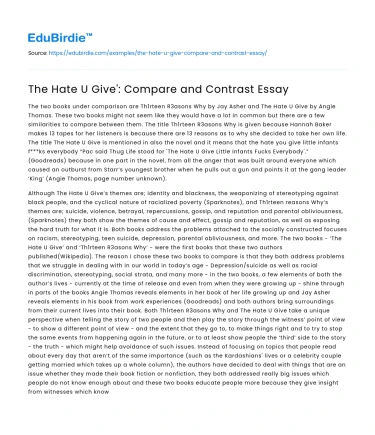Introduction
'The Hate U Give' by Angie Thomas is a compelling narrative that delves into the complexities of race relations, identity, and social justice in contemporary society. Through the eyes of Starr Carter, the novel presents a poignant exploration of the systemic inequalities that permeate the lives of African Americans. The narrative is not only a reflection of fiction but also a mirror to real-world events, echoing the sentiments of movements such as Black Lives Matter. This essay aims to compare and contrast the thematic elements of 'The Hate U Give' with real-life societal issues, examining the intersections between literature and life. By analyzing key themes such as police brutality, community dynamics, and personal identity, this essay will elucidate the broader implications of the novel in understanding and addressing racial injustices. Furthermore, counter-arguments will be addressed to provide a holistic view of the novel's impact and relevance.
Police Brutality: Fiction Versus Reality
Central to 'The Hate U Give' is the theme of police brutality, a topic that resonates with contemporary real-world events. In the novel, Starr witnesses the fatal shooting of her childhood friend, Khalil, by a police officer. This incident is a fictional reflection of numerous real-life cases, such as the tragic deaths of Trayvon Martin, Michael Brown, and George Floyd. Such incidents have sparked nationwide protests and debates, highlighting the pervasive issue of racial profiling and excessive force used by law enforcement. According to a 2020 report by Mapping Police Violence, Black Americans are disproportionately affected by police violence, being three times more likely to be killed by police than their white counterparts. This stark reality underscores the novel's portrayal of systemic injustices faced by African Americans.
Save your time!
We can take care of your essay
- Proper editing and formatting
- Free revision, title page, and bibliography
- Flexible prices and money-back guarantee
While critics may argue that the novel exaggerates these issues for dramatic effect, the data and real-life cases suggest otherwise. The narrative of 'The Hate U Give' serves as a powerful reminder of the ongoing struggle for justice and equality, urging readers to confront uncomfortable truths about racism and discrimination. By juxtaposing fictional events with real-world statistics and cases, the novel underscores the urgent need for reform in policing practices and accountability mechanisms.
Community and Identity: Navigating Dual Worlds
Another significant theme in 'The Hate U Give' is the exploration of community and identity, particularly as it pertains to Starr's experiences in navigating her dual existence between her predominantly Black neighborhood and the predominantly white private school she attends. This duality is emblematic of the broader struggles faced by many African Americans who must reconcile their cultural heritage with societal expectations. Starr's internal conflict and her eventual empowerment reflect the real-life challenges of code-switching and identity negotiation faced by minorities.
Sociological studies have shown that individuals who straddle different cultural environments often experience identity fragmentation and stress. As noted by Dr. Beverly Tatum in her book 'Why Are All the Black Kids Sitting Together in the Cafeteria?', such experiences can lead to a complex interplay of self-perception and external perception, influencing one's sense of belonging and identity formation. Counter-arguments suggest that these identity struggles are not unique to African Americans but are shared by all individuals navigating multicultural spaces. However, the racial dynamics and historical contexts unique to African American experiences add a layer of complexity that is adeptly captured in Thomas' narrative.
Social Justice and Activism: Fictional Narratives and Real Movements
The novel also underscores the importance of social justice and activism, as Starr evolves from a silent observer to an active participant in the fight against racial injustice. Her journey mirrors the real-world activism seen in movements like Black Lives Matter, which seeks to address systemic racism and promote equality. The character of Starr becomes a symbol of resistance and empowerment, challenging the status quo and advocating for change.
Critics of social justice movements often argue that such activism can be polarizing and divisive. However, the novel illustrates the power of collective action and the potential for literature to inspire social change. As noted by scholar Dr. Ibram X. Kendi, narratives like 'The Hate U Give' play a crucial role in educating and mobilizing individuals to confront and dismantle oppressive systems. By weaving personal stories with broader social themes, the novel serves as both a reflection and a catalyst for real-world change.
Conclusion
In conclusion, 'The Hate U Give' offers a profound exploration of the socio-political landscape affecting African Americans, drawing parallels between fictional narratives and real-world issues. Through the examination of police brutality, community dynamics, and social activism, the novel underscores the enduring struggles for justice and equality. By addressing counter-arguments and providing a nuanced understanding of these themes, the essay highlights the novel's relevance and impact in contemporary society. As a work of fiction, 'The Hate U Give' transcends its narrative boundaries, serving as a poignant commentary on the realities of racial injustices and the collective responsibility to advocate for change. In doing so, it reinforces the power of literature as a tool for empathy, awareness, and social transformation.






 Stuck on your essay?
Stuck on your essay?

